Comic Book Historians
Tom Orzechowski Career Interview Part 1: X-Men Letterer
Alex Grand, Bill Field, and Jim Thompson interview legendary Comics Letterer, Tom Orzechowski discussing the history of Comic Books alongside his personal and professional involvement in comics starting in 1958, through the impression that Jack Kirby, Steve Ditko and Artie Simek made in the Silver Age, through to the Detroit Fan Fair Comic Convention that united him, Jim Starlin, Arvell Jones, Rich Buckler, Al Milgrom and Mike Vosburg as they entered Marvel Comics with a passion pushing the company into the Bronze Age. Tom also describes his career lettering over 6000 pages of Chris Claremont's run on the Uncanny X-Men through the series' best years, and why they left it in 1992. Edited & Produced by Alex Grand. ©Comic Book Historians. Uncanny X-Men ©Marvel Comics, No Sense Remix - Standard License. Support us at https://www.patreon.com/comicbookhistorians
Podcast and Audio ©℗ 2019 Comic Book Historians
Alex Grand, Bill Field, and Jim Thompson interview legendary Comics Letterer, Tom Orzechowski discussing the history of Comic Books alongside his personal and professional involvement in comics starting in 1958, through the impression that Jack Kirby, Steve Ditko and Artie Simek made in the Silver Age, through to the Detroit Fan Fair Comic Convention that united him, Jim Starlin, Arvell Jones, Rich Buckler, Al Milgrom and Mike Vosburg as they entered Marvel Comics with a passion pushing the company into the Bronze Age. Tom also describes his career lettering over 6000 pages of Chris Claremont's run on the Uncanny X-Men through the series' best years, and why they left it in 1992. Edited & Produced by Alex Grand. ©Comic Book Historians. Uncanny X-Men ©Marvel Comics, No Sense Remix - Standard License. Support us at https://www.patreon.com/comicbookhistorians
Podcast and Audio ©℗ 2019 Comic Book Historians
Tom Orzechowski: After all this trouble communicating with you guys on the webpage, it’s good to finally get some voices.
Alex Grand: It’s a real treat for us too, Tom.
Bill Field: Boy do we have a lot of questions for you. And we’re gonna start this all with a kind of this is your life, Ralph Edwards kind of thing. Those of you who don’t remember Ralph Edwards, he–
Jim Thompson: Which is everyone.
Bill Field: Okay, give me break, guys. I’m a little smitten today because I’ve been a fan of Tom’s for years, decades even, I’m really excited about this. So, Tom, to start with, when you were a kid, did you want to be a letterer, or what did you want to be in comics?
Tom Orzechowski: When I was about 14, I figured I wanted to draw for comics. I started reading when I was about 5, if you can call that reading, but it probably was. My reading comprehension was usually about 3 years ahead of myself all the way through elementary school. Ahead of my classmates. I could spell kryptonite before I could spell a whole lot of anything else, and it was just that kind of a thing.
Tom Orzechowski: But around age 14 or so, I guess when a lot of people stopped drawing, I was still kind of doodling, and I figured “I could do this, couldn’t I?” And when I was 15, I was at what was the third comics convention in the Detroit area which is 1968. I didn’t just say that. I met Arvell Jones, well the most notable name in that group, penciled comics not long after I started lettering them. It was in this comics clubs, which is what it was, the Fantasy Fans Comic Collectors Group, and Arvell was the nucleus. He was the alpha male in that group, even at that age. He was the leader. People followed him, people joined in with him on his projects.
Tom Orzechowski: I realized really quickly, once meeting Rich Buckler, who was a 34 year old and adjunct to this club and then Starlin, and then Milgrom, and then Vosburg, everyone a few years older… I can’t ink. Milgrom can ink and Terry Austin drawing – I can’t do what Terry does. This is ridiculous. But as they were writing their own comic strips, I could spell better than they could because I was taking journalism in high school. Penmanship was never really my strong-suit, but I wanted to be part of what was going on. So I was editing the scripts, which were less considered than the illustrations by these guys, and just took it upon myself without really being asked to letter the scripts that I was lettering, because no one wanted to letter.
Tom Orzechowski: And, oh gosh, by the time I was about 17 or so, having met Buckler, he was still getting scripts from Warren, and Starlin starting penciling for John Romita about a year later. Clearly there was a movement of possibility of getting further into the door at DC or Marvel or Warren. And so when I was 16, I started going to New York for conventions there and taking lettering samples and go to Marvel, cause that was the place to be, go to Marvel. And I never really was able to walk into the office, which looked like it was just a tiny back office of a warehouse or something, just kind of board partitions and not a whole lot of people in there, and the guy would come out and give me a couple pages of artists and mixed lettering on top of [inaudible 00:04:19] pencils on Captain America, that kind of thing.
Tom Orzechowski: And I met Tony Isabella by this time, in the ‘zines, maybe at a convention or two in New York. When he got a job at Marvel late in ’73, toward October of that year. Pardon me, ’72. They needed someone to do the least appreciated job in lettering corrections. I called the day after Christmas at my job, and they said “Look, if you can get here in two weeks there’s a desk you can work at in the office”. So I was there a week later, January 2. In about a month it’ll be my 45th year. I was doing lettering corrections on the British reprints of the first couple of years of Marvel, ’62, ’63, for the British trade. Which was thrilling, cause I bought those books and now I’m working on them just a few years later. And that just led to getting a little more skill, a little more skill, and within about five months I was lettering some color comics.
Bill Field: About how many u’s do you think you had to had the words in those British comics?
Tom Orzechowski: Oh God, countless. Yeah. Respelling the word check, respelling the word curb, which is k-e-r-b.
Tom Orzechowski: Tony invented… Because Thor, Iron Man, Ant Man were all fighting communists, and that wasn’t really happening in 1973 anymore, and the Brits didn’t care about the communist threat the way the Americans were kind of steamrolled into it. So Tony came up with idea Bordavia was the oppressive otherworld nation. And so a different insignia had to be put on the tails of the airplanes, and the uniforms, and the word Bordavia had to be substituted for “communist” whenever you saw the black widow or anyone like this showing up in the pages. There were lots of little tweaks, and doing them a thousand times, and you kinda remember them. And so I was lettering Chris Claremont’s X-men scripts a couple of years later. I met Chris in ’73 also, when he was just one of the proofreader guys.
Tom Orzechowski: Chris’s parents were both British, and I think he spent his first five months in the UK, and then they moved to the States, and he learned all the British spellings in those first five months of his life – they would stick with him in his scripts. And so part of my unofficial job was simply to put those into US spellings, and I knew more British spellings than anyone else. So that was just a heaven sent opportunity for me. I knew the job, just from having corrected people.
Alex Grand: Nice. So there was actually a British connection, almost. A UK connection between you and Chris Claremont. That’s fascinating. That’s interesting.
Tom Orzechowski: And one other thing, which I won’t name a name here, cause it’s maybe a little too embarrassing after all this time, one guy I knew in Motor City days, and I was lettering his ‘zine work… Then when I got to the office, he kind of finessed me into lettering his book. And one time he misspelled the word strength, four times; four different spellings of the word strength in the same issue. And I felt like “I can correct these, that’s fine”, and I did some minor tweaks on some of the captions and dialogue and stuff, and then Roy pulled me aside and said “You know, you’re not paid to do any editing, you’re paid to letter, and we’ll take care of the editing”. I said “Okay, I guess my fan days are truly over if I can’t just take liberties anymore.”
Bill Field: One of the first comics I ever saw you letter for, and it still stands out in my mind, is…I can’t remember the number, you’re gonna have to help me if you can remember, but I believe it was Captain Marvel #33?
Tom Orzechowski: My first was 28. Jim’s first was 24, so I was installed almost immediately.
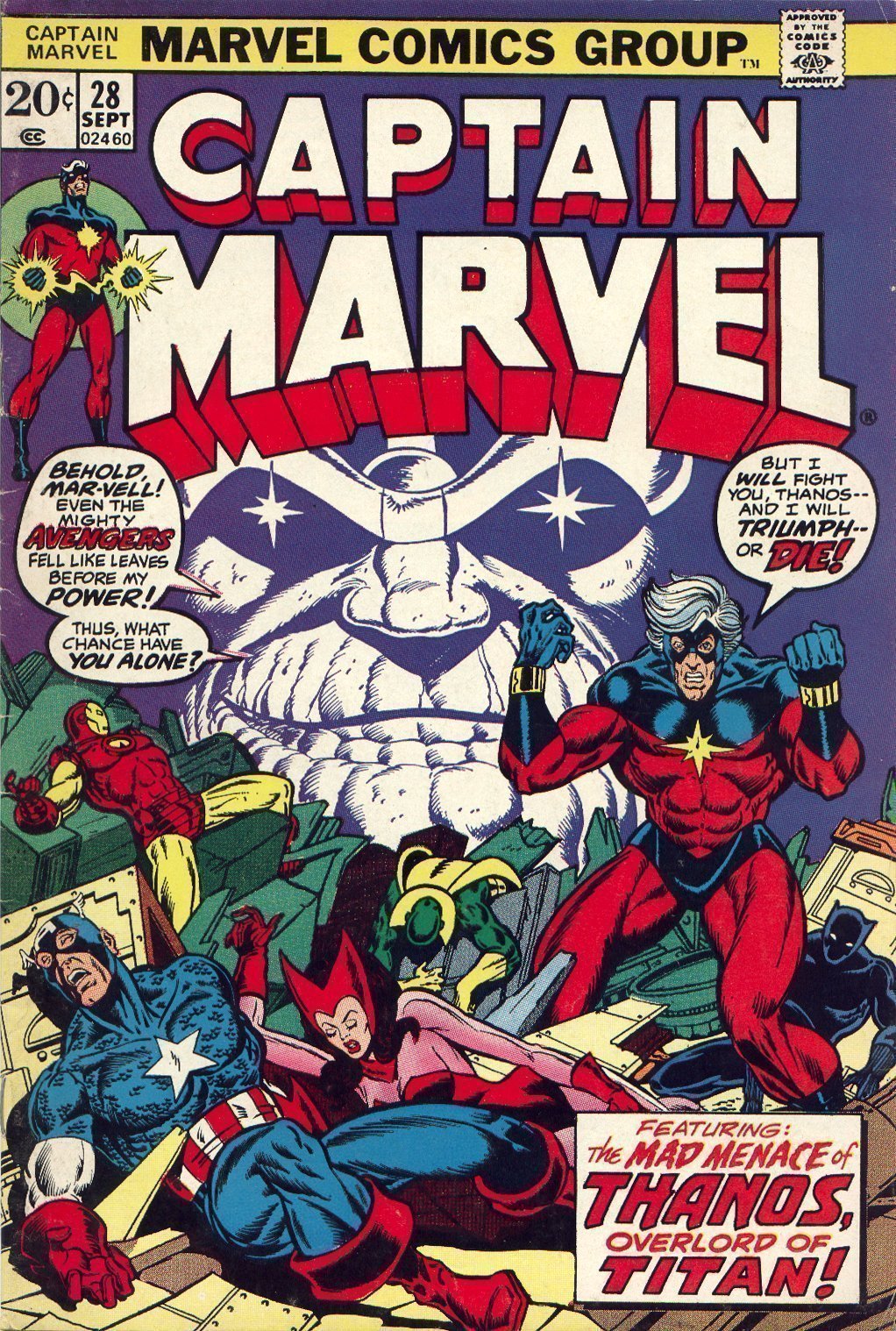
Bill Field: I remember noticing that you were the only letterer who did things to TV standards. You would use a letter that was similar to Star-Trek, or you would use a lettering similar to TV logos I’d seen. It was almost like you were bringing popular culture full circle with your lettering. I don’t remember anyone else doing that, and to me that’s one of your strengths. Do you want to comment on that?
Tom Orzechowski: Fan boy comes to mind. Star-Trek was the deal after all, wasn’t it? It’d been off the air for two or three years by this time, but it was just etched into my retinas. The lettering style they used for the title was just unbelievable to me. It looked so futuristic and sleek, and I don’t know where it came from, I haven’t seen anything similar in any of the type books from that time. Someone I guess was just clever and did something moderately interesting and futuristic, as if someone figured this show should have legs on it, let’s give it a little bit of extra goosing, make it a little more memorable than it would be otherwise.
Jim Thompson: Tom, can we go back to the fanzine stuff for just a couple of minutes? I was curious, did you ever have any communications with Fredric Wertham?
Tom Orzechowski: I did. That was kind of unexpected. It must have been… It’s amazing, it slipped my mind for decades, but Wertham hasn’t been a topic in the last thirty-five years the way he was when I was doing the ‘zines in the late sixties, when Seduction of the Innocent was only a fifteen year old book. Around ’70, ’71, ’72 he did a book, and I can’t recall the title of it; I’m sure one of you guys knows it-

Alex Grand: A guide to Fanzines, something like that?
Tom Orzechowski: Maybe that was it. I’ve never seen a copy of it, never read it.
Tom Orzechowski: Seduction of the Innocent was in my public library. I read it, I guess all of us did around 1968, 1969, when ‘zines were starting to be everywhere. You couldn’t go to a convention without seeing tables full of guys selling their ‘zines by then.
Tom Orzechowski: Supposedly Seduction of the innocent was ghostwritten. I don’t know the name of the ghostwriter, I’m sure he compiled notes, but English was not his first language. I’m sure someone ordered the stuff and organized it and finessed it a bit.
Tom Orzechowski: He wrote a long letter to his fanzine publishers in the early seventies, because of all of his worst fears and prognostications did not come to pass. We did not become a generation of psychopaths and rapists and so on… Leather jacketed hoodlums -most of us didn’t.
Tom Orzechowski: So he probably went through an issue of Rockets Blast Comics Collector, or Comics Buyer’s Guide and just simply sent twenty-five cents, fifty cents in coin, in an envelope to a hundred thousand fanzine publishers, and just got copies of everything, went through them… All this fan artwork, Steve Fabian and Rich Buckler, all these guys and their Steve Ditko aspirations. And no sign of criminality. No sign of uncontrolled aggression or any word in anything that people are writing. The ‘zines were all love letters to the comic book editors and publishers and creative people and it really changed his… He had to re-examine his own preconceptions fifteen years earlier, and so he quoted me for a sentence or two. I probably was one of hundreds who were quoted for a sentence or two, but there’s one of my footnotes in the history of comics is that Fredric quoted me in one of his books.
Alex Grand: I read the book six weeks ago and I found that paragraph and posted it. I was delightfully surprised. I was like, “Hey, Tom Orzechowski!” And so it’s cool to get your feedback on that. That was really great.

Tom Orzechowski: He was just this genial fellow. I think we had a letter or two back and forth and asking him why is it you hate comic books so much? He says “No, it wasn’t the comic books as such, as a form, it was just the criminality or the exaggerations of the child comic books, the EC Comics in the first part of the fifties, and that went away pretty quickly and it never resurfaced.”
Tom Orzechowski: If when Joe Orlando was editing House of Secrets and those books for DC toward 1970, 1975, whenever that was, it was a pretty soft version of the EC books. It was a senseless script, but you didn’t have people beheading their wives or anything like this anymore.
Tom Orzechowski: In a post-war commie red sphere society, maybe that was not the most irrational thing to have published. It’s too late to try to analyze it now, it was 75.
Bill Field: Well, my grandmother debated him in the late sixties, early seventies. My grandmother was a big proponent of comic books as a reading teacher. It seems as though he backed down quite a bit on lot of the things he had said in the fifties, because he said a lot of the same things you’re mentioning: that kids didn’t become psycho killers, Batman and Robin did not lead a lot of kids that wouldn’t be homosexual to homosexuality, and those kind of things. It does seem like he backed down quite a bit. So in his older years, that he realized that he might have been completely mistaken in some respects.
Tom Orzechowski: Well how nice, and if I contributed in a small way then okay.
Alex Grand: Yeah, to his enlightenment. Just food for thought, how much do you feel the comics code changed the trajectory of the way kids reacted to comic books? Do you feel like that played a role in guiding them away from potential bad behavior, or it made no difference?
Tom Orzechowski: I don’t think kids who were spending their dimes on comic books instead of cigarettes were ever going to be any kind of a threat, to tell you the truth. And also trends in comics at that time, until you had the big Marvel revolution… Well, let’s say the silver age revolution from about 1958, 1960 and onward, comics were just changing their figures. The whole superhero thing changes so quickly. It even modified itself as the talent became more experienced and new people like Kubert and Gil Kane came in.
Tom Orzechowski: Through the forties, the late forties read nothing, looked nothing like the early forties. Early fifties comics looked nothing like the late fifties comics. The themes… Westerns came and went, romance comics were less sensationalistic as time went on. I think Seduction may have had an effect, but comics just changed. Interests, different media come in, TV comes in, westerns come in, b-movies, drive-in movies come in… So people look for different things in comics, or used to, every few years. So I think there would have been a change away from EC and crime comics anyway.
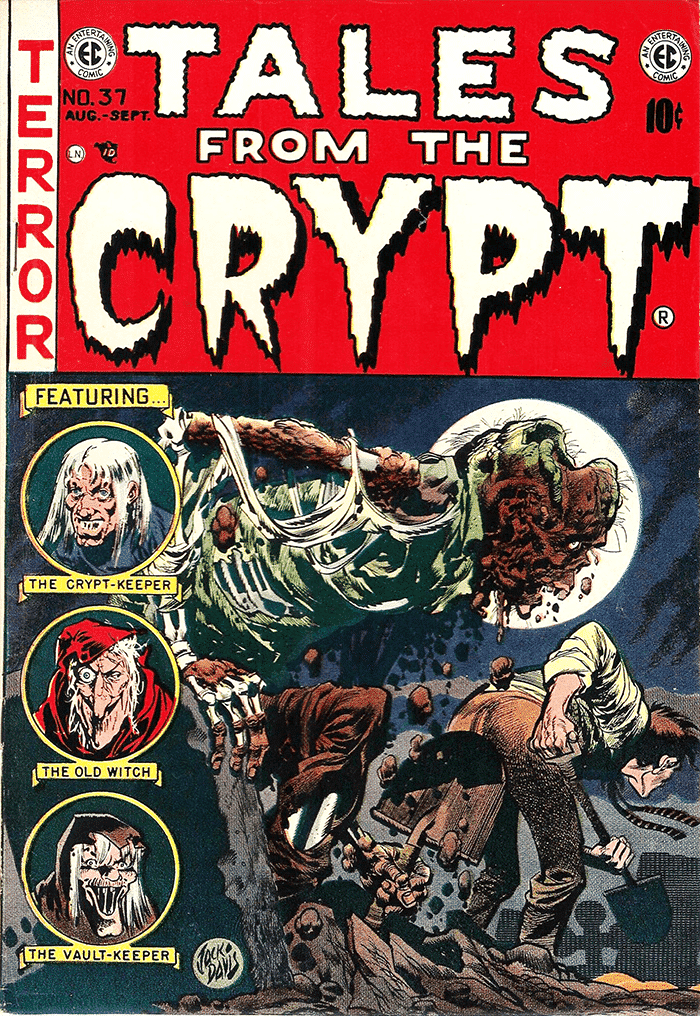
Tom Orzechowski: If you read eight issues of Tales From the Crypt or that whole set of EC horror books… Marvels monster books, they had those monster books from the later fifties, the Kirby, Ditko, Don Heck ones – you’d read three or four of them and you’d read them all. They just didn’t have any themes inside them. Now if Jack Davis and Al Feldstein and that gang, Graham Ingels who had gotten kind of bored anyway, if readership wouldn’t have been falling off… Maybe it had been. The new trend books unfortunately didn’t do any business at all and those are the best of them Johnny Craig, Al Williamson an entirely different focus than-
Jim Thompson: Aces High, yeah some of those are just fantastic.
Tom Orzechowski: Fabulous and you can pick them up for a song, maybe for ten dollars, fifteen dollars if you don’t mind battered condition copies.
Jim Thompson: It’s the Kurtzman books for me. The two war tales, those are the ones that I love the most.
Tom Orzechowski: Two-Fisted Tales?
Jim Thompson: Two-Fisted Tales and Front Line Combat.
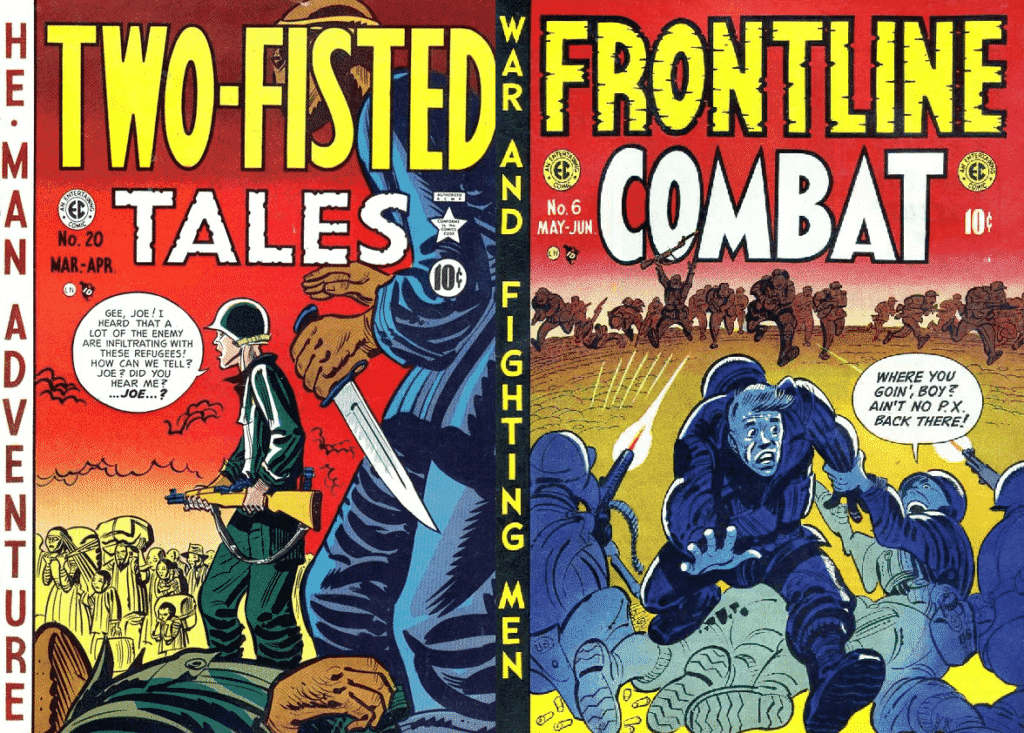
Tom Orzechowski: Yeah, yeah.
Bill Field: That group of core artist they had, with Kurtzman controlling it tightly; I loved those books. I loved the Kurtzman covers myself, also. I thought his covers were some of the most explosive, although simplest in some respects, they were some of my favorites of all time.
Tom Orzechowski: George Evans was fabulous and Johnny Craig was fantastic.
Jim Thompson: The historic ones that Wood was doing at that point? Massacre at Agincourt – those are just fantastic, too.
Tom Orzechowski: From a practical sense, you have to wonder, especially with Wally Wood and Johnny Craig was my favorite among all the EC artists, how they made a living doing that extent of detail, that extent of rendering and research. Because the budgets were good, but they couldn’t have been enough to justify Wally Wood going crazy with the amount of science fiction or historical background he was doing. Even on the suspense-type stories, the shock suspense story type things, the background detail, the interior scenes, the draperies, the carpets… He must have been a pauper doing that kind of work.
Jim Thompson: John Severin too, on the war stuff. His were lovely as well. I’m curious, after EC folds, did you become a Marvel person primarily or were you always keeping DC and Marvel both in your pockets?
Tom Orzechowski: My earliest comics came from cousins who were four or five years older than I was. So I’d see World’s Finest and Action Comics and Strange Tales and just the whole gamut of… Because I started seeing a lot of Atlas Monster comics, and then Fantastic Four #1, just all on one big load, around 1960, 1961 and they were just so much more exciting. I like Strange Adventures and Mystery in Space better than Action Comics because I thought Supergirl was just such a wimp kind of a strip, she just cried all the time. How old is she, anyway? When she landed, she was about fourteen, fifteen-
Alex Grand: Yeah, fifteen something, yeah.
Tom Orzechowski: But no, for her to be in love constantly with the horse guy and the merman guy, she had to have been 17, 18. Still in the orphanage; certainly no younger than 17. But she’s just weeping constantly, and there’s nothing interesting that she’s doing as a super being. Even the latest Superman pushing planets out of the orbits in their late stories and she’s doing nothing but adopting a cat… All those groups, those tree monsters and spider monsters. DC had nothing to compare with that. Strange Adventures was okay and I like those a lot, but DC was like cool jazz and Marvel was rockabilly. And this Kirby guy, this Ditko guy, these people are crazy. And Infantino was laid back and Murphy Anderson was meticulous, he was like your good uncle. But Ditko and Kirby, they were like the guys who mowed the lawn across the street.
Bill Field: Yeah, and the Ditko stuff was so creepy at the time. What really turned me into a Marvel fan early on, and still to this day, his work to me there at Marvel and Charlton, is some of the absolutely most atmospheric fright-fests that I can think of in comics. He, still to this day, has a huge impact on me.
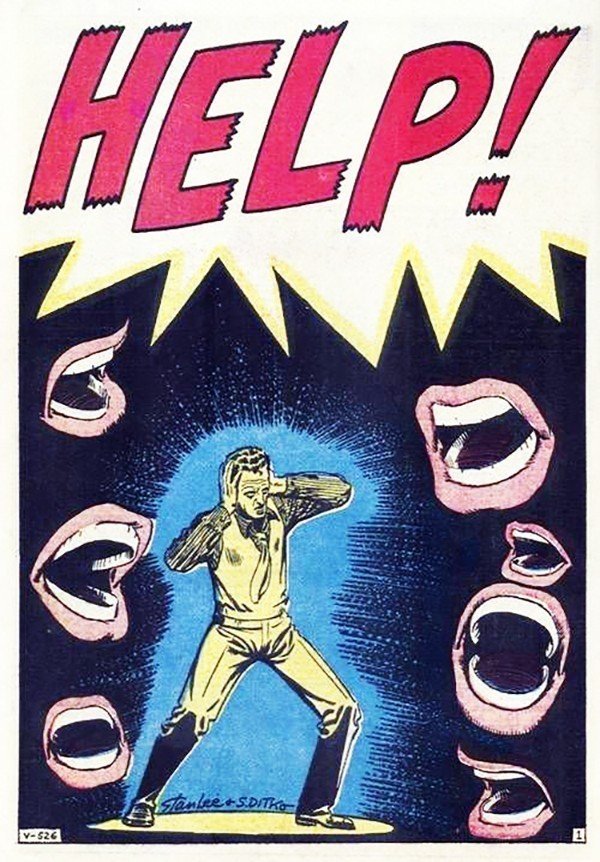
Tom Orzechowski: He brought that emotion that.. emotionalism would be the word that Kurtzman was giving those covers. Ditko, when he was drawing scientists or jungle explorers or Jonah Jameson. No one was designing characters like he was. These people were out of their minds, they were such zealots. He was unique. Ditko is unique.
Jim Thompson: Yeah, that’s a really good point. Marvel really did… One of the things that made a major impact, in terms of their success, was those supporting characters. That DC didn’t have anything beyond the girlfriends. Except for maybe Superman and Batman had a few, but J. Jonah Jameson was something different.
Tom Orzechowski: I think that Steven Grant talked about this, he and I had some conversations about that kind of thing. He thinks that Ditko was clearly plotting Spider-Man by issue 10. When Jonah had the final page where he just lays his heart on the line, “Why do I hate Spider-Man?” Stan would not have plotted that.
Tom Orzechowski: I think the entire Jack Davis quality, the cartoon, the bigfoot quality that Ditko brought to things was unparalleled. I find in fact the genre made of Spider-Mans and then Gil and Ross Andru – these are like fiction. It’s like Ditko’s were the only true Spider-Man issues.
Alex Grand: Wow, yeah.
Jim Thompson: So about how old were you, Tom, when you were reading those? And I have a reason for asking this.
Tom Orzechowski: Well I was born in ’53. So right after F1, I was eight or nine in 1961. I was exactly the right age, the target age. Eight, nine, ten years old when all these books were debuting, Ant-Man and Iron Man and these things, I was about ten.
Jim Thompson: I was born in ’59. When I was 12, that’s when you started in on things like Jungle Action and Captain Marvel. And those were mine, that just knocked me out of my seat. You were part of what my favorite Marvel era was, even though I loved that other stuff, and the Ditko and Kirby. But when Gerber and Englehart, McGregor, and those guys were working, that was just it for me. And you were part of that, so can we talk about that a little bit, just as a fan boy myself, I want to hear… When you started on things like Jungle Action, did you realize what a game-changer, difference that was for many things that had preceded it?
Tom Orzechowski: Oh yeah, that moment… a three year moment was just explosive. From the first issue of Conan, which is officially where the Bronze Age began, when suddenly Marvel turned a corner with Roy’s instincts plus, the things they licensed: Doc Savage, Conan, Planet of the Apes and the decision to expand the line because there’s suddenly a distribution. Any backup character, Man-Wolf for pity’s sake, everything got its own title for two, or three, or six issues just to see if it would stick.
Tom Orzechowski: And Tomb of Dracula stuck, and Killraven… Maybe two years of Killraven, maybe two years of Jungle Action with the Panther… But McGregor, and Starlin, and Gerber, passion just oozing out of their pores. I’m just not reading in fact the Marvel Essential of the Black Panther, the Jungle Action issues and Don went on a bit, but once you get used to rhythm… The same could be said about Chris Claremont. Once you get used to the rhythm of their speech and the character nuances, Chris’s own eccentricities, Don’s own eccentricities… Like the way Don named his villains, Killmonger? What’s Erik Killmonger supposed to be?

Tom Orzechowski: That’s all passion. And the two Abott and Costello followers of Killraven who were always getting knocked on their butts by T’Challa every issue.
Tom Orzechowski: Don was just so deeply into the emotional relationships. He brought an American woman, his lover with him back to-
Jim Thompson: Monica Lynn.
Tom Orzechowski: Yeah, Monica Lynn. Everyone is slagging her constantly, the tribal women saying “Who is this woman? Why doesn’t he find someone here who can be his peer and his mate? Why did he import this hoity-toity American woman who just doesn’t know a thing about who were are, doesn’t belong here?” And they were giving her grief every single issue, she was trying to bear up under it. That was phenomenal, that was amazing. My own particular Marvel experience in ’73 was I just couldn’t bear to live in New York, inside of seven months, I split to the West Coast where I had another opportunity piling up. So I lettered only four issues of Jungle Action.
Bill Field: Is this where you got into underground comics, Tom?
Tom Orzechowski: Well I was reading those, I think it was at Buckler’s place in ’68 that I saw Zap #1. What is this thing? I’d never seen anything like that. I guess I was familiar with Betty Boop cartoons, the older Popeye cartoons, I was vaguely aware of the stylistic things that Crumb was playing off of. But Zap was just clearly out of his right brain, there were no filters, it was just pure unadulterated nonsense of the grandest sort. And it changed my perception of comics and of lettering for all time, because he was basing his work in the twenties, which I had no exposure to at that time, I was 17, 18 years old.
Tom Orzechowski: At the first opportunity I had, when I was in my first couple years professionally, I started seeking out old books of graphic arts and seeing what was going on in the twenties: the jazz records, and the recording business sheet music, things that Crumb was just overwhelmed with. Wow! The Star Trek thing you mentioned then Robert Crumb and undergrounds which I’d already read a lot of by the time I started at Marvel. Roy pulled me aside one day when I was still doing… Okay, this is getting convoluted.
Tom Orzechowski: Working on Monsters Unleashed and and Tales of the Zombie and this kind of thing, Vampire Tales, then Marvel black and whites in ’72, ’73, I was doing new titles for their ’53 prints to make them look a little more contemporary looking. And Roy told me my titles looked too much like underground comics. I figured cool, I’ve learned something; I’ve achieved something. And he didn’t like the look of it, so I tried to look a little more like Marvel, but once I got to the west coast, was doing Werewolf by Night and after a couple years, X-Men I figured these aren’t tied to the Marvel universe – I can do anything I want.
Tom Orzechowski: So doing Savage Sword of Conan, I was trying to work more in the art nouveau approach that Barry was bringing into some of the titles he did on the Conan book, when he was still doing that. On X-Men, I had developed a couple of quirky things that I probably overdid, just because it didn’t have to look like Fantastic Four. It didn’t have to look like Marvel mainstream. The underground comics were quite an influence on me because they were just… And likewise Doc McGregor, likewise Jim Starlin, were the mainstream exponents of the same thing. It was just heart and soul out there on the page; no filters. It was very amazing. We knew that we were doing something different. We were the new generation of Marvel, only ten years after the first generation of Marvel.
Bill Field: And you also had things like Star Reach, which was kind of a combination of more the Marvel style, but with an underground approach, and things like that during the same period.
Tom Orzechowski: So Mike Friedrich, first scripting for Julie Schwartz, I think Detective Comics and Batman when he was 19. Actually Mike’s first sale to DC was Spectre #3, which Neal drew and then an issue of The Lantern which was drawn by Gil Kane. A retelling of The Detective #27 story, drawn by Bob Brown. So Mike was rolling high, Mike was just on top of the game.
Tom Orzechowski: But after a couple of years, he petered off. He was writing Justice League, they weren’t that impressed by it and then there was, for some reason, a break with DC he went to Marvel. His writing just wasn’t holding up. He didn’t seem to have anything new to bring to it. And he saw that this was clearly deteriorating, and so he created the Star Reach comic, which would be creator-owned. So midway, he called it ground level, not overground, not underground. And so, creator ownership all the way. Which makes it difficult to re-print this stuff now, because some of those artists are dead.
Tom Orzechowski: But he dangled this in front of myself, Englehart, Starlin, Alan Weiss and Brunner. Just “I’m creating this new comics company out on the west coast. You guys aren’t from here or New York anyway, why don’t you move west, you’ll really dig the scene out there.” I came along also, and so we lived all together for a while and then went our separate ways after a year or so. But I stayed with Star Reach, and Frank did for a while. And that was so cool. And yeah Frank did own what he was doing, and Jim owned what he was doing and I think they gave everyone a lot of ideas, you know we don’t need to stick with the Marvel mainstream. Englehart did, because he was having the time of his life, getting all the tops book of that time. And it was a good opportunity for me because it gave me the opportunity to not work in the mainstream Marvel style, I never really did master that anyway.
Tom Orzechowski: Danny Crespi, who lettered a lot of the Marvel covers after Rosen and Simek retired in the early ’70s. Danny never once asked me to work more in the Marvel style. He saw that I knew what I was trying to do, and I was using good references and not just making up nonsense, I was actually getting good outcomes I guess, if I can flatter myself. And so he just let me keep going my merry way. It was fun. Comics have always been fun. I think that’s the whole point of it if all goes well, you have fun with it.
Jim Thompson: Was Epic Illustrated a big deal? Because you were part of that from the very beginning.

Tom Orzechowski: Yes I was. Starlin and I, after all we were fans together, when he had a new thing coming up as often as not, he’d give me a call and see if I had the time to input. So I did Metamorphosis Odyssey for Epic Magazine, and I lettered Craig Russell in Epic Magazine and a few people I’d known… I started to letter Bill Sienkiewicz but you can’t stick with everything, there’s only so many pages you can handle in a month.
Jim Thompson: Yeah that brings me to a question that’s bugged me forever. Why didn’t you get to do Death of Captain Marvel when you were so essential to the entire run? And in Warlock as well?
Tom Orzechowski: Didn’t I do Death of Captain Marvel?
Jim Thompson: You’re not credited for it.
Tom Orzechowski: Is someone else credited, was it Novak or somebody?
Alex Grand: You did Marvel Graphic Novel 2 through 4, your name is associated with so many Starlin projects. The lettering is currently credited to Jim Novak for The Death of Captain Marvel.
Tom Orzechowski: Then I guess it was Novak. Maybe I was just over busy that month and so Crespi assigned it to Novak, because Jim and I were kind of acquainted but were never really friends, because he was a bit older; he’d been in the military already when I was just getting started.
Tom Orzechowski: Like the first Warlock that he did was lettered by Annette Kawecki and then I did the half dozen or so that happened after that.
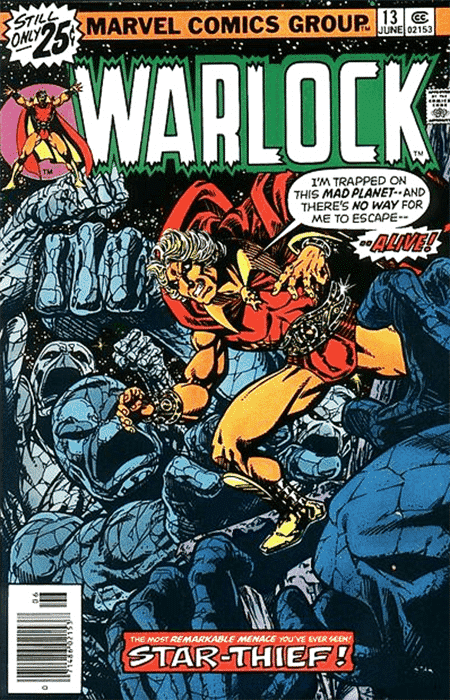
Jim Thompson: Those are crazy good, I love those Warlocks that he did. I think that’s my favorite stuff of his.
Bill Field: Let me ask you something, Tom, that I’m real curious about. Did you approach the graphic novels any differently than you had your regular comic work? Did you feel like it had to be elevated because the price point was much larger, it was on better paper, it was square-bound… Or did you just approach it the way that comics worked before that?
Tom Orzechowski: It was the same kind of gig, as far as I was concerned. Longer, which meant a higher pay point, but I just did the kind of work I was familiar with. As I was starting to say, Jim and I, since we weren’t that tight in the first place, once it came to the Dreadstar series for Epic, the Epic Imprint, that was Novak also. Novak was the best guy; he was the top of the stack. I wouldn’t say I was necessarily a second tier, but you had Novak and Joe Rosen doing Spider-Man, Fantastic Four, Thor, all of the main line books, and I would get the side projects because my work was just that much more eccentric.
Advertisement
Jim Thompson: Did your star really rise with X-Men?
Tom Orzechowski: I guess you could say that. It was a lot of work, a lot of regular work.
Bill Field: Well you got X-Men pretty early on, I mean you didn’t start your true run until a little later, but if I’m not mistaken, you lettered X-Men #94 which was the first new regular issue of the regular title since it had been canceled years before and shortly after Giant-Size X-Men #1 came out.
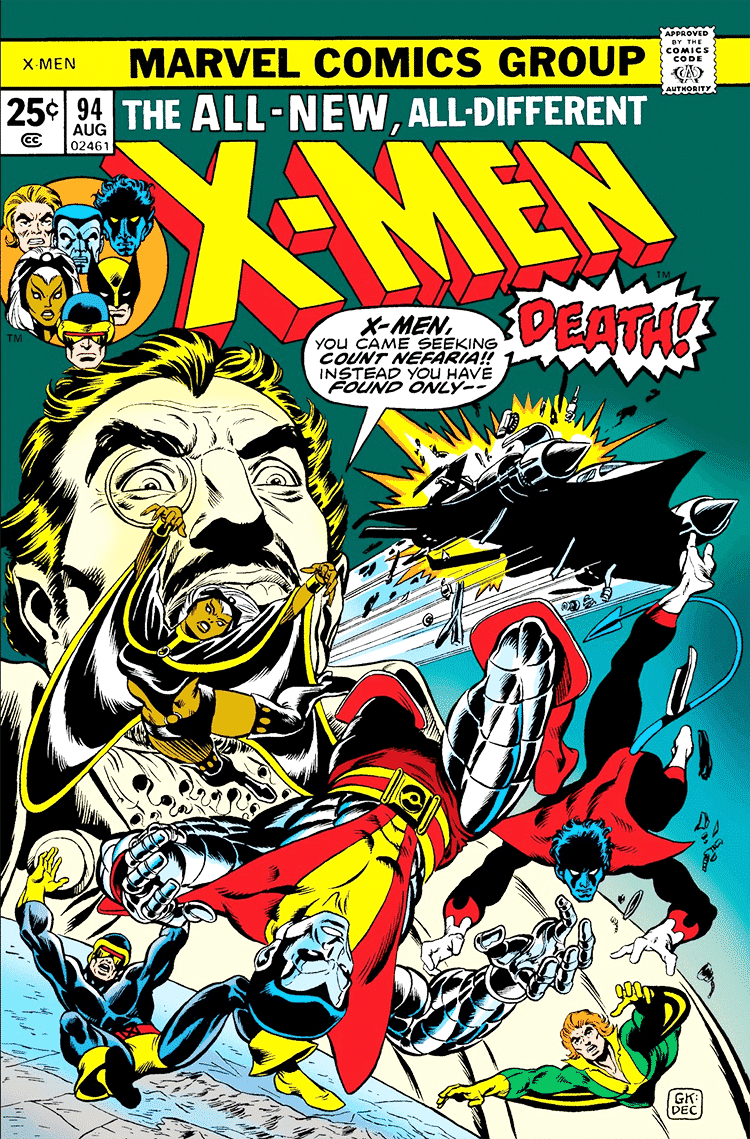
Tom Orzechowski: I don’t think I’d seen Giant-Size #1 because I was living in Berkeley at that time and I was told later it was this miraculous thing that Verpoorten and then Danny kept sending me work on the west coast because everyone else was hugging the office all the time. Janice Chiang, everyone who was close to the office… you drop in once or twice so we can get a book and do it. And they kept mailing things to me, which took days. There was no Federal Express then. It would take three or four days for the book to cross the country, they’d keep sending me stuff out there. And I guess John would just grab whatever was on the top of the stack of books that were going to Costanza or Rosen and just give those out here and there in any direction, because most books didn’t have regular lettering assignments at that time.
Tom Orzechowski: I don’t think I’d seen Giant-Size yet when X-Men #94 arrived.
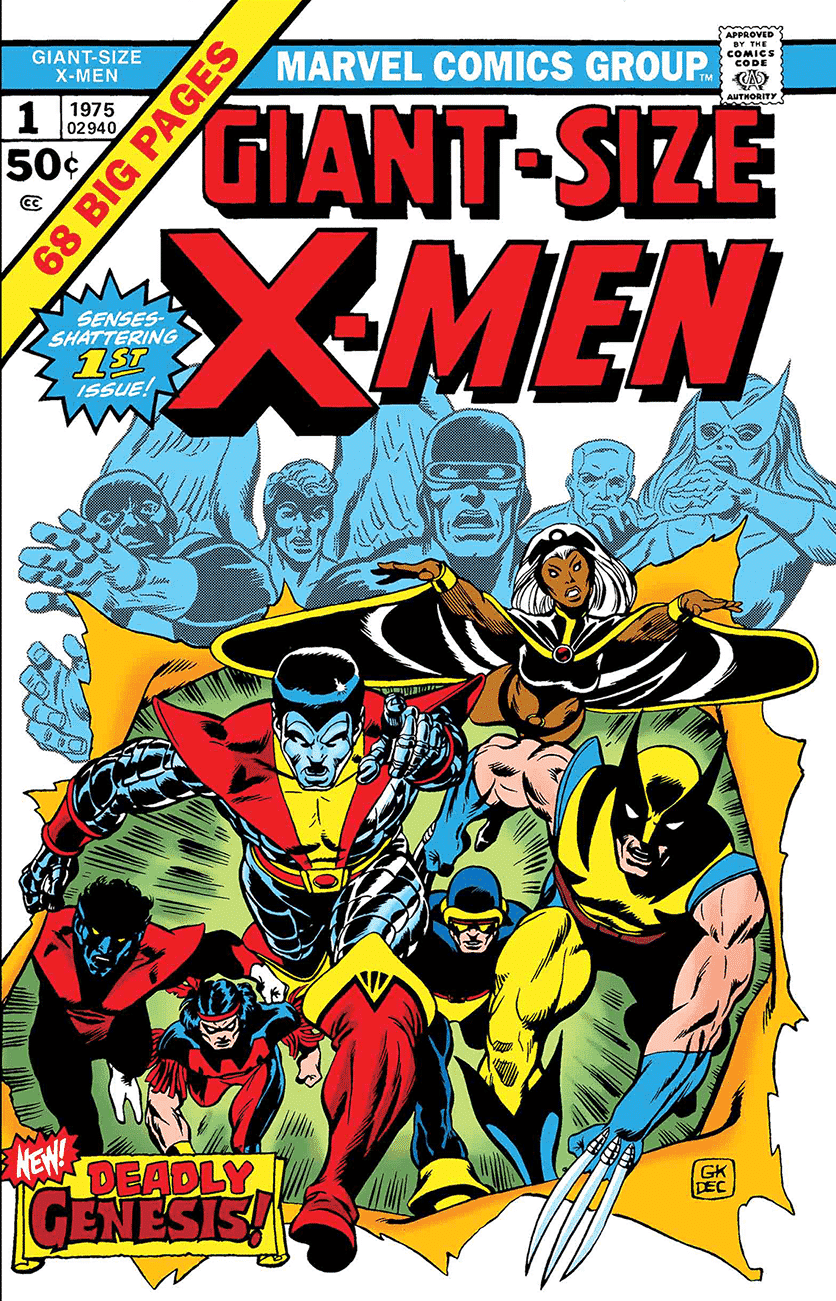
Bill Field: Oh, I see. Was it a surprise to you when it became so popular so fast?
Tom Orzechowski: It wasn’t that popular that fast. Byrne was telling me that people assumed he was just a mega-star status, making millions of dollars an issue in royalties, but no the book didn’t sell that well, even toward the end of the Phoenix cycle. It was picking up incrementally, month after month, building pretty solidly, but it wasn’t yet the really big seller. So he was making money on the re-prints later on.
Alex Grand: Like classic X-Men reprints of the later eighties, you’re saying?
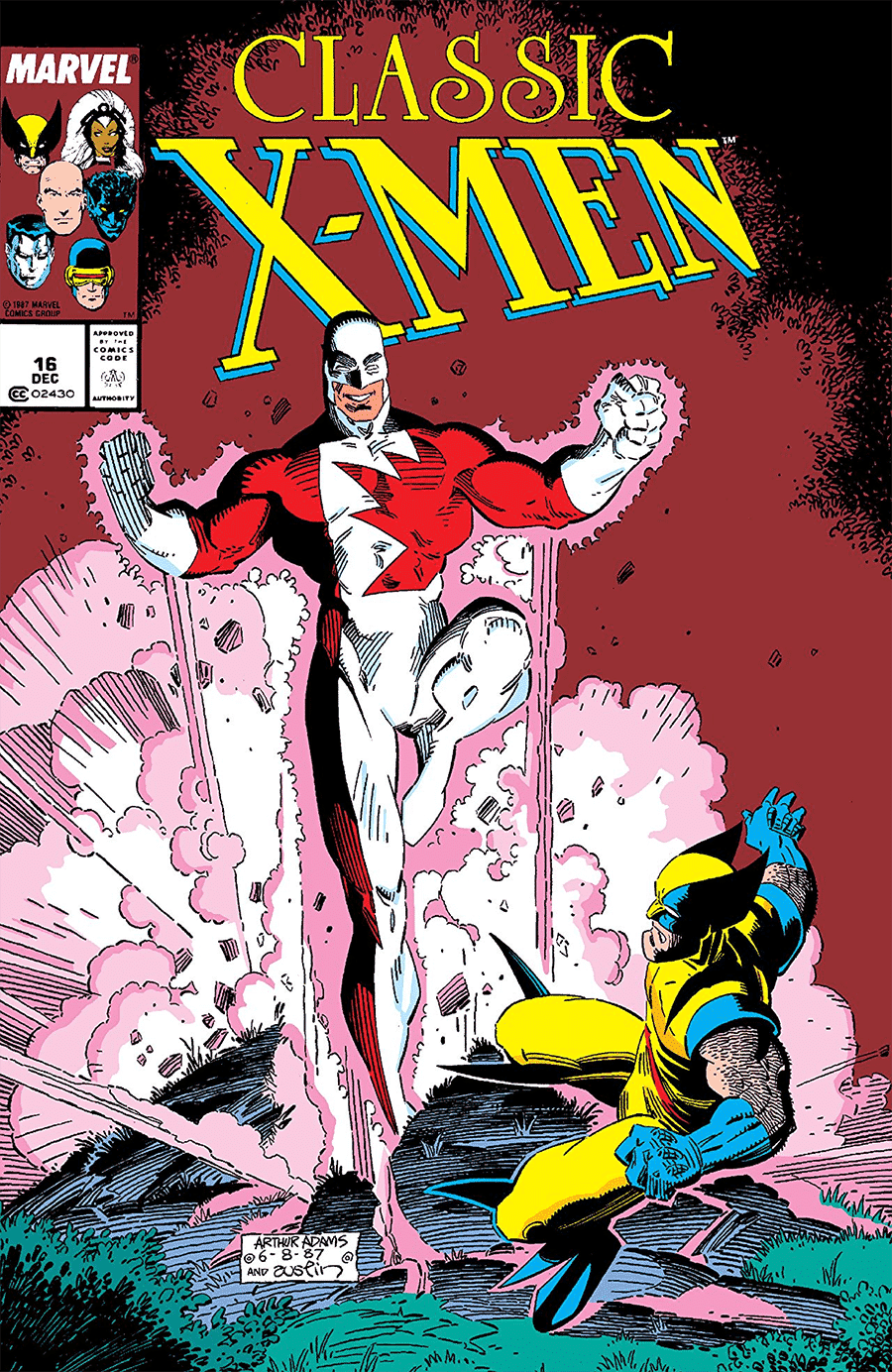
Tom Orzechowski: Yeah, he made a good professional reputation on this, he could pretty much write his own ticket. But the book didn’t sell that well.
Alex Grand: So when you saw X-Men #94, did you have the impression it was going to be that successful? Did it feel like “Wow, this is impressive,” or was it more like “okay, this is a cool assignment, I’m going to letter it.” What was your impression when you first saw those pages?
Tom Orzechowski: What impressed me was that it was Dave Cockrum, because I’d seen his Legion stuff for a few years. And holy smoke, who are these characters? There’s Charles, and there’s Scott, and there’s Jean, and a few others. It’s like, “Wow, they’re bringing this thing back. How cool is that?” And it was energetic and nice, I’ve got two or three days to do this thing.
Alex Grand: What was your impression of Dave Cockrum’s creative input into the X-Men? Do you feel like he really revitalized it by bringing that legion of superheros’ energy into the comic book?
Tom Orzechowski: The X-Men book, the worst selling of their books, that’s why they canceled it after only five years, six years. And it seems like they didn’t truly know what to do with it. Neal and Roy did some amazing things in the year or so that they did it, in fact that’s why it was revived, because the sales were perking up pretty noticeably during that time. The Steranko issues were fun to look at. It was kind of a flabby book over all. No one seemed to know what to do. So you know, Werner Roth issues didn’t do that much magic, and so they then started doing different logos every issue to highlight the storylines. And it seemed like an unnecessary team. An unnecessary book in the line.
Tom Orzechowski: Dave and Chris put an urgency in there, and Len, that… New characters, they really don’t know what they’re doing, they’re… I don’t know, maybe it’s just the dynamic of the artwork, because Cockrum was a star.
Tom Orzechowski: His Legion issues did set that series on fire. They’d been just a bottom tier series. When he was suddenly installed, instead of redoing the costumes, and Cary Bates was writing it, and so there was a different aspect to the scripts. The Legion as drawn by Curt Swan and John Forte and then Win Mortimer; they didn’t sound like they were teenagers. They were young adults, they were approximately thirty years old, just like everyone else, and Dave made them look younger and gave them a style consciousness, they were kind of flirty.

Tom Orzechowski: He brought that energy into X-Men and Chris was able to play on that real successfully because his actual background, he went to Bard College. Well he was a young dramatic player who was an actor, he was drama major. All of these things come together. Certainly Dave’s visuals were completely unexpected.
Alex Grand: John Byrne, his first X-Men issue was #108, with the imperial guard. And you lettered that issue. How did you feel about that transition from Dave Cockrum to John Byrne on the X-Men at the time, when you first saw those pages?
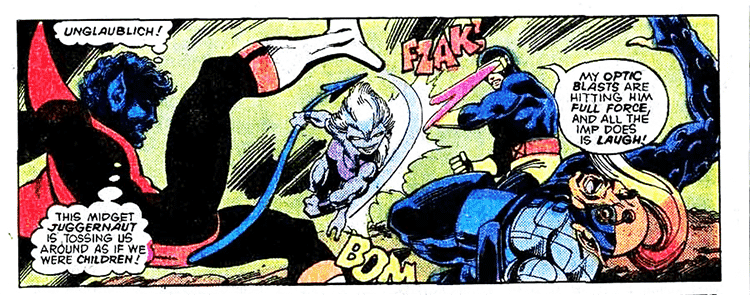
Tom Orzechowski: The immediacy was different. Dave had a lot of closeups and John was doing a lot of middle shots and distance shots to the whole team together at one time. He didn’t start doing closeups for a while. And they were skinnier. I felt he was a good successful artist because his style was reasonably polished, he was spotting a lot of heavy blacks, he wasn’t afraid to draw anything. He was not shy, he was not just being sketchy. The pencils were very full and tight. Having Terry on the book also, it’s like wow, we’re in business now, this is going to work.
Alex Grand: Nice.
Tom Orzechowski: I think that John started as early as #108, but I guess you’re right.
Bill Field: Yeah, I think he did run #108 and then he did one with Arcade and the circus, I think you did that one as well.
Bill Field: I’m glad you brought that up because that is the first comic book that actually made me notice the letter. It was all your fault, Tom. It’s your fault man, it’s your fault because you brought this excitement of circus poster art to comics and you did that quite often. Whatever it called for, you would go more Sci-Fi, whenever it would call for it, you’d go more huckster. You made it bigger than life and honestly, you were the letterer that made me realize lettering was an art form.
Tom Orzechowski: It’s calligraphy, of a more casual sort. And I think was #111. Sideshow performers on the cover. A nice Cockrum cover. I’d forgotten that was Arcade, yeah. Well, thank you.
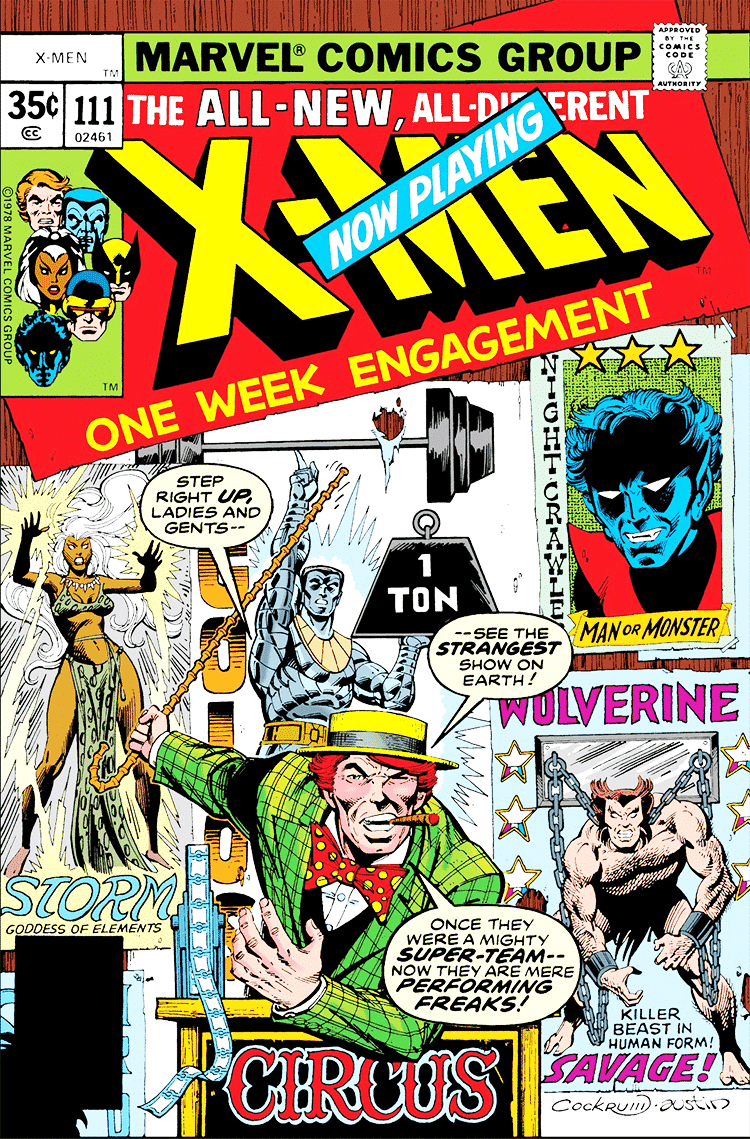
Tom Orzechowski: I moved to Berkeley when I was about 23, so just past college age. It’s all bookstores and cafes, like Ann Arbor or an actual college town and not just a campus. And so I was just almost living in Moe’s Books and Aardvark’s Books, and Shakespeare’s Books – Shakespeare and Company, and I forget the name of the others. And just picking up graphic arts books by the armload and poster from 1910s and earlier and sign painting out of the forties and just anything, anything I could find. Calligraphy… and how do they come across these outcomes? How do they bring the layouts? So yeah when it came down to the issue #111 was and I made the ornament on the letter S at the wrong angle, and so that haunts me to this day.
Tom Orzechowski: It seemed like my duty to bring that level of interest in there because, by then I’d done fliers for bars already, and for bands. And rather than just giving the same kind of title every issue the way they had in the EC books, or a lot of the Marvel books. You know, Simek and Rosen could put a lot of variety in there without a whole lot of trouble but I figured let’s really go whole hog on this, let’s go crazy and make it look like it’s been typeset, like a graphic designer did this.
Tom Orzechowski: One of the bullpen guys chewed me out one time years later. When I was trying to get people interested in different typography magazines and stuff, different subscription things I was getting. He said “Look, yeah you’re living at Berkeley. Yeah, learning all the time, you can spend all day working on one title to make ten bucks. I got alimony to pay. I can’t do that kind of nonsense. You need to just shut up, and lighten up, and make some money.” And he was right. I didn’t take his advice, but he was right in giving it to me.
Tom Orzechowski: But yeah, I did take pleasure in doing silly title work for Savage Sword that led to more Myth and Legend-y, or for Tarzan, or for X-Men, handling these things differently for the title work, anyway.
Bill Field: I often notice you used an awful lot of upper and lower case, which for your issue first page titles, kind of puts you in a whole different class than the other guys. You were willing more to experiment and push the realm. I think to this day, those comics still trumpet to me how great comics were in that era, and I still think you had so much to do with that. It’s just amazing getting to talk to you about this period, because I think it was so influential and so important to comics.
Tom Orzechowski: Well thank you, but as my critic pointed out, I was spending hours to make ten dollars. I look at these things now and I say, “yeah, that one came out okay. That one worked out well.” But they didn’t look like Marvel, and so ultimately in the grander scheme of things, if you appreciated it, if it made my work stand out from everyone else, then I suppose that was a good thing. I never did understand why no one else took up the challenge to do more elaborate title work. I guess they realized you can’t make any money that way. Then at the end of the month, when you’ve got to pay your bills, the money is important.
Bill Field: That has to be a payment in and of itself.
Tom Orzechowski: Arthur Adams’ work, not so much the work he’s doing now for private sales, which are rendered magnificently in all directions, when he was penciling those X-Men annuals and specials toward 1990, whenever that was, no one else was working on three point perspectives in every single panel. But he was because how could he not, he’s Arthur Adams.

Bill Field: And he employed more of an underground style at the time too because of all of the pointillism, the odd things he was doing, as well as the perspective issues you were mentioning and so I think he and Byrne opened up a new era to me of what it meant to be a penciler and what it meant to be comic book artist. That stuff still stands out to me. Your lettering on it just pushed it that much further into the greatness realm for me.
Tom Orzechowski: Well maybe the position I was in, because I’d been opening packages every month; original artwork and then later on it was full size xerox copies and I’d be working on overlays that they would paste onto the artwork. I didn’t know if I’d be getting Rick Leonardi, or John Romita Jr, or Barry Smith, or Arthur, Craig Russell… I didn’t know who’d be drawing the book that month. It was by week for the summer, so it’d be maybe 16, 18 X-Men issues a year for a while. Just seeing that kind of variety of approaches.. Kevin Nowlan, Bret Blevins, Steve Leialoha
Tom Orzechowski: The same characters, the same story continuity, but suddenly an entirely fresh silly crazy personable style. How could you not get juiced and have it influence your work when suddenly this Erik Larsen ssue, Todd McFarlane issue, Rob Liefeld issue, it’s just a crazy life, it’s a miraculous thing; a place to invent.
Jim Thompson: I haven’t heard you mention Paul Smith. How did you enjoy lettering to his version of the X-Men?

Tom Orzechowski: Oh those were glorious. I mean, we were talking about Byrne a few minutes ago but the big question was… Dave [Cockrum], wonderful man, and wonderful illustrator, he could not do a monthly. When he was drawing the Legion, I don’t think they were full length. And maybe they were, maybe that just got on his nerves after a while. I forget who was inking them.
Tom Orzechowski: But when it was clear he was not going to be able to continue X-Men, I thought well who’s going to replace Dave? How can we possibly find anyone to continue after Dave? And then Byrne was in the wings. And there was some doubt whether he was ready yet. And then John stayed for about three years, and then well who’s going to replace John? I mean possibly find anyone to replace John? Then Dave put his hand up and said “I can do that.” So he lasted about a year, and then in the monthly schedule was once again just more than he could stand. Who’s going to replace Dave? And then Smitty showed up out of nowhere. I think he’d been an animator with Ralph Bakshi, actually. Which would really loosen a person up, all that nutty stuff. And his stuff was glorious, and he did less than a year. He did either ten or eleven issues.
Bill Field: Was that it? Wow, it had such an impact on me, I would have said at least three years. That’s amazing. Those are some fantastic issues.
Alex Grand: Beautiful. Beautiful issues.
Bill Field: I still look back at those.
Tom Orzechowski: Yeah, wonderful covers, and Chris was on fire. So we got Rogue at that time and they fought the… well they essentially were on the Nostromo and fought the aliens at that time. And he was up for all of it, and so Storm got her Mohawk at that time which, I think was Chris’ idea. That was really shaped then and the fan mail was just – oh 100% against it. What a horrible thing to do to Storm, put her in leathers and studs and a Mohawk, what’s wrong with you people? No cape?
Alex Grand: You know, with the Dark Phoenix Saga and Days of Future Past, were you enjoying the story as well, when you would see it unfold in front of you?
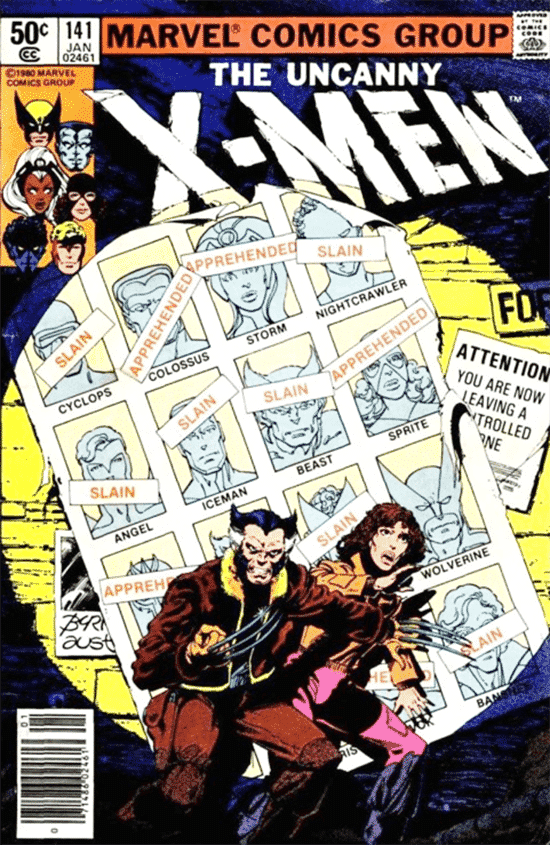
Tom Orzechowski: Oh yeah, because there was no way of knowing what was going to happen next. Here’s Jean in a corset and eight inch heels and so on, and she’s into it. Chris felt a remarkable freedom to completely throw out anything anyone would expect. Sue Storm, Ben Grimm, these people are always going to have the same relationships, we throw in Crystal occasionally to shake things up. It was only Byrne that really shook up the Sue Storm thing later on.
Tom Orzechowski: But Chris felt no loyalty at all to the old days and he was under no editorial pressure, which is more to the point. Well, Jim Shooter, by this time. So he didn’t really conform to the pre-existing X-Men. They figured okay this book is detached from its history, which made it unique.
Tom Orzechowski: The others had to stick pretty close to their history, as I’m sure all three of you guys know that in Chris’ original outcome, Jean was simply lobotomized to get the Phoenix out of there. And she just said “Well no, she’s broiled an entire planet of asparagus people, she has to die. You can’t allow this to happen.” That was already published, you can’t take it back, so we have to kill her. And so we’d already finished that issue and gotten about a third or halfway into the subsequent issue, so they pulled #137 and had the final chapter completely re-done, and she did die. And #138 had basically Scott and Jean walking through the grounds, because they were going to live in a little shanty in the back of the mansion and set up their lives as a married couple and they were reminiscing about the previous 150 issues or whatever it was… Then it became the X-Men at her grave site reminiscing about the previous 150 issues.
Tom Orzechowski: But I still had xeroxes of a lot of that issue where it’s just Jean looking distanced and like part of her brain is missing and Scott’s slowly realizing she’s really not the Jean I fell in love with anymore and hoping to get her back out of this post traumatic shock, but there’s no way of knowing. And I’m not sure that plot point was actually going to go eventually because Chris had to throw it away, but he probably still has his notebooks, which I guess will be donated to the Columbia University Library or the Billy Ireland Library in Columbus, at some point.
Alex Grand: The sound effects of BAMF and SNIKT – did you letter those?
Tom Orzechowski: Well, yeah. Yeah, I didn’t create them, but yeah, those are Chris’ scripts and I-
Alex Grand: And then you’d write the BAMF word in Nightcrawlers, Potter, Teleport?
Tom Orzechowski: Yeah.
Alex Grand: Yeah, that’s great. That’s really great. I love that.
Tom Orzechowski: The job of the letterer involves the story titles on page one, the sound effects… Yeah, the artist doesn’t do those, for the most part. Occasionally, an artist will do the sound effects of the story title but mostly, that’s up to me. Or Novak, or whomever. And then the captions, yeah we do the balloons; those aren’t drawn by the artist.
Bill Field: I love your explosion noises, by the way, when you would take over the entire bottom of a long panel and it’d be “bababaaam!” Or whatever, I can’t think of the exact… And the way you would make it almost quake, I could hear those sound effects in my head. More so than I ever could in comics and I still think about that stuff in my dreams and I love how you crack a bone or…
Alex Grand: As far a letterer, here’s a controversial question – not too controversial, but Artie Simek you’ve said was an influence on you, is that correct?
Tom Orzechowski: Oh sure, yeah.
Alex Grand: The night Gwen Stacy Died, that Amazing Spider-Man when Spidey catches Gwen falling off the bridge and her head swings back and then there’s a lettered sound of her neck snapping; do you remember that?
Tom Orzechowski: Vaguely, yeah.
Alex Grand: Do you feel that neck snapping, does that confirm that it was Spider-Man as the cause of Gwen Stacy’s death?

Tom Orzechowski: Okay, here comes the hate mail. The origin of this, and this gets conflicted, but I was… I knew Conway when I got there, so one of the final books I bought before I knew I’d be working in the office was Amazing #124 and Conan #24, the final Barry Smith issue. So I remember that panel, I remember the situation, I was like “what?” But Stan, and this has gotten scrambled over the years as Stan remembers things one way and then he remembers them another because life was so busy, he wasn’t keeping notes.
Tom Orzechowski: But the relationship between Peter and Gwen, they were still about 20 or 21 years old in continuity, had gotten so intense and dramatic, and lovingly rendered by Romita the romance artist for four years or something. Either they’d be getting married or she’d have to die. There’d be no way to just end the romance, just kind of let it drift away somehow. And they were too young, it would be too massive a change in the scenario if they were to be married because that would change the framework of the series too much. And Parker is the bad luck kid after all, they abandoned a lot of that in the Romita days, where in Ditko’s issues, like every fourth page, something would go wrong.
Bill Field: Aunt May’s had a stroke? For the 12th time this month?
Tom Orzechowski: She can’t afford the medication, and she’s in the hospital? And Betty Brant just slapped his face… Why was Betty, she was an executive secretary, why would she hang out with a 16-year-old photographer?
Jim Thompson: Yeah, that was so wrong.
Alex Grand: That’s true. Huh, that would be in the headlines today.
Tom Orzechowski: Yeah, they had problems with the age relationships because Stan was a romance writer, that was the entire shtick of the Marvel age was that he was taking romance comics to the next level and giving them powers and costumes.
Tom Orzechowski: But as far as the Gwen Stacy things go, the Goblin pushed her off the edge; his intention was that she die or that Spidey would be distracted. Spidey had a second to react and so yes, he swung and caught her, but he didn’t have time to plot the trajectories and consider what would happen and g-forces and things you guys can probably name easier than I can… Yeah, the act of catching her did things to the physical body which it could not bear; she could not have survived. But Goblin pushed her… It was a moment you can’t do over. There’s no going back. He saw her fall; he saved her. Clark saved Lois hundreds of times in that way, and she never felt any ill effects, she never dropped her notepad or pencil, her hat never fell off. So Goblin, you bastard, you may be complicit in her death but unfortunately Peter was because he didn’t have the time to think it through. In the history of the book to that time, 124 issues, if he never caught anyone in free-fall that way. I don’t think so.
Tom Orzechowski: But you know, Robin used to push people off the edges of unfinished skyscrapers back in the forties. We assumed they died. And he was always grinning, because it was just make-believe violence, it wasn’t real violence. But unfortunately I think that Peter was complicit in Gwen’s death, which is only made a thing because Goblin decided that nothing mattered anymore and that he would endanger her life. Did I in any way address the question?
Alex Grand: You did, yeah that was great. I wanted to get a letterer’s perspective on that snap point and that was perfect, thank you.
Tom Orzechowski: And Conway told me at that time that there’s understanding from Stan who was still in the office every day. I saw the man every day. They cannot be married, this relationship cannot go on. Unfortunately, she has to die which is really a remarkable thing to have done. Let the thing go that far, because John and Stan were writing it up to about issue #100 or something and then Roy took it over briefly before the team. Conway was exactly my age. So when I was 19, when I was 20, he was already writing. I think he started writing at 16.
Bill Field: This takes us to a place where I wanted to go a minute ago. You made the trek over to Image Comics with a lot of the other Marvel folks and a couple of the DC folks and you then lettered Spawn, and how long did you letter Spawn?
Tom Orzechowski: I’ll be starting issue #281 on Tuesday.
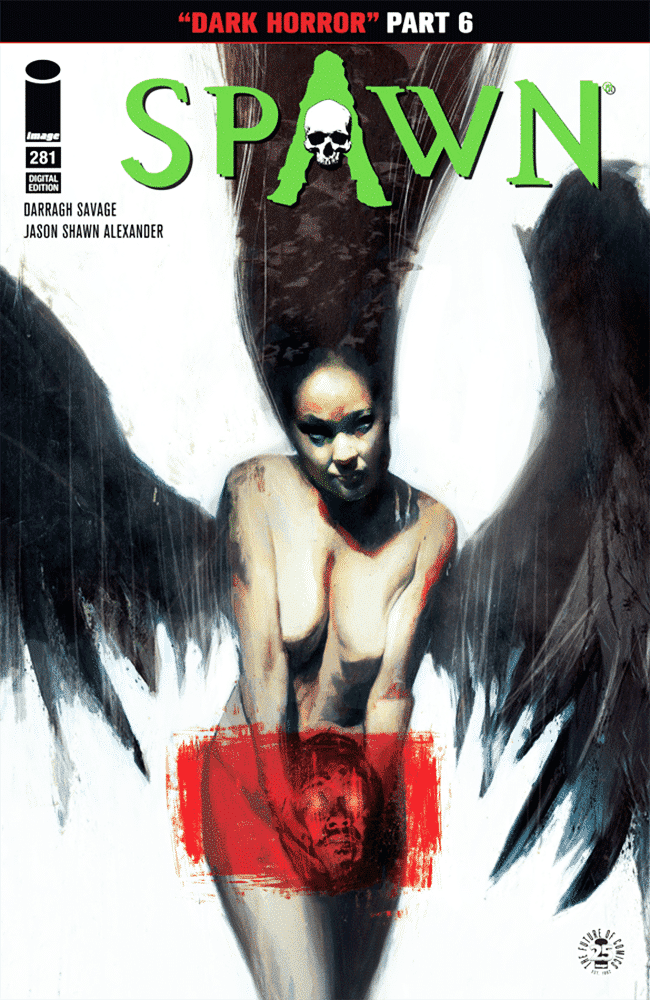
Bill Field: Wow.
Tom Orzechowski: That’s 281 issues that I’ve been involved in.
Alex Grand: You’ve lettered every issue of Spawn?
Tom Orzechowski: I didn’t do issue #44 because Todd wanted to set a precedent of a page rate if I weren’t to be on the book, so my wife did that one. I may have ballooned at least some of it or sound-effected some of it, I don’t remember. But I did edit the script, because it was my job by that time; I was editing scripts.
Alex Grand: Oh, that’s great. Around that time when everyone left Marvel, did Chris Claremont leave first, or did you leave first? What exactly was going on that caused you guys to leave?
Tom Orzechowski: Chris was pushed. Bob Harris wasn’t yet Marvel editor-in-chief, he was just the editor on the X-Men titles, which was about four books by then, maybe some other stuff. And Chris had been writing it for about 18 years solid, and Jim Lee was penciling by then and I think Bob simply felt that it was time for a change. He wasn’t that happy with Chris’ approach in ways I’m not in a position to enumerate – that’d be Chris’ interview to give. It came to issue #280 of Uncanny.
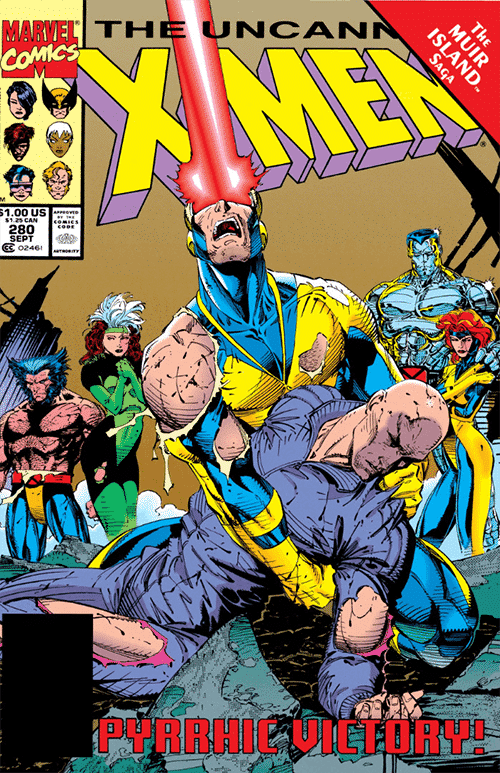
In a manner I cannot recall, but which you could look up if you have the books, Bob didn’t like the final moment, the final two or three pages of the plot outcome and told Chris “No, it should go this way instead.” And Chris said, “Well no, that’s nonsense. I’ve been writing this book for 18 years, I know the characters.” And Bob said, “Yes, but I’d like it to be this way instead.” And Chris said, “Well I’m not going to do that.” Either Tom DeFalco or else Fabian wrote those final 2 or 3 pages and Chris realized at that moment, “Oh well I guess this is not my book anymore.”
Tom Orzechowski: Now of course, realistically it was not his book in the first place, he did not own it, it was not a career art project. But it had been his; it was his baby for 16 years, it’s old enough to go to college. So at that point, he agreed to stay on Uncanny for about another year it might have been, you can look that up… Then he agreed to write the first five issues of the second X-Men title- This sounds like a Tom DeFalco- Shooter didn’t want to have an X-Men solo book, he felt that Wolverine was a team player. And one of the first things DeFalco did when he was in the chair was to give Wolverine a solo book. X-Men with no adjective. Chris wrote the first five, and I think it was at the end of the second issue, there was introduction of a character called Omega Red. That was Jim’s character – Chris didn’t know he was going to be in there. So already there was starting to be movements that were going beyond Chris’ control of the book. And so Chris shrugged and said, “Well, I’m leaving in a couple of issues anyway.” And so Omega Red was the character on the cover of issue #3 or #4 or something.
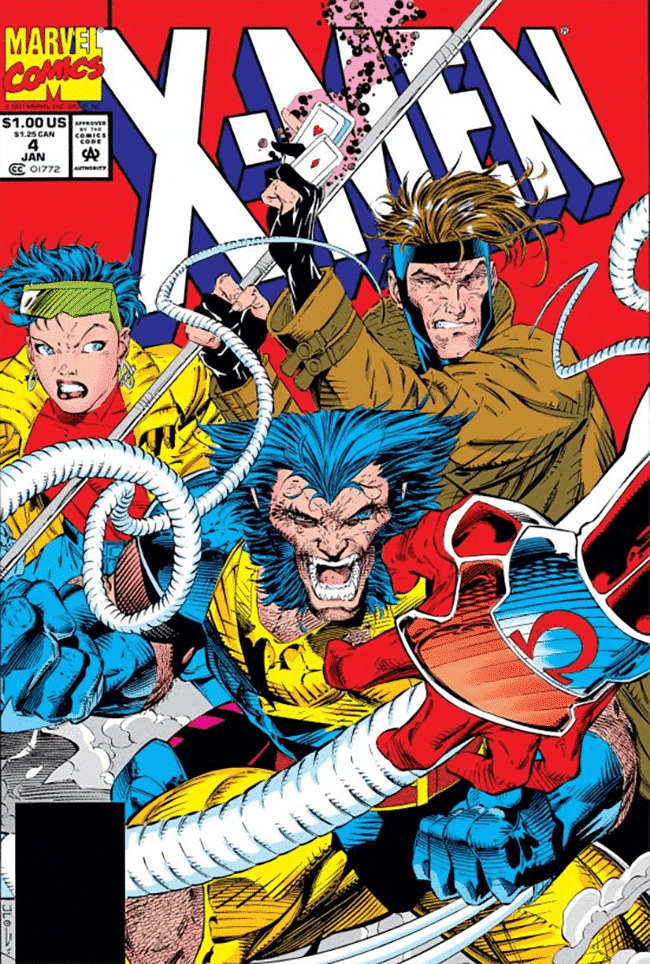
Tom Orzechowski: Not a moment was missed. Chris scripted Uncanny #291 or something then issue #292 with Scott Lobdell and then Fabian took over the other book, or vice versa. Chris wanted an all-or-nothing situation. There was a similar situation with Master of Kung Fu around 1975 or something. It sold like gangbusters. And by the time of the fifth issue or so, it was decided there was going to be a black and white Billy Henson Kung Fu Magazine featuring Shang-Chi stories. But I think Steve’s thing was he couldn’t write both the monthly and the magazine monthly, and if he couldn’t control the character completely, he didn’t want to be involved anymore. So I guess Doug Mench took over both of them at that moment, because Doug could write a thousand pages a week with no trouble. Doug is like the unsung giant of the later Bronze Age, I guess. He wrote more pages than anybody. He wrote all the Principle books at DC and Marvel, or nearly so.
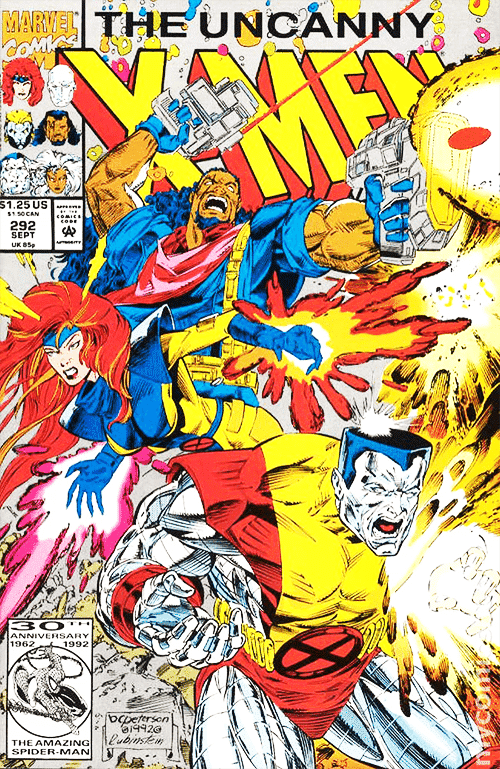
Jim Thompson: Hey, great stuff. Master of Kung Fu especially, I think his best book. But Moon Knight is awfully good too, as well.
Tom Orzechowski: Then he wrote Batman for the longest time and just on and on, all over the place, Doug Mench everywhere you look. Grant Morrison got all of the props, and Don McGregor, and Chris Claremont, and somehow Mench didn’t get noticed.
© 2020 Comic Book Historians